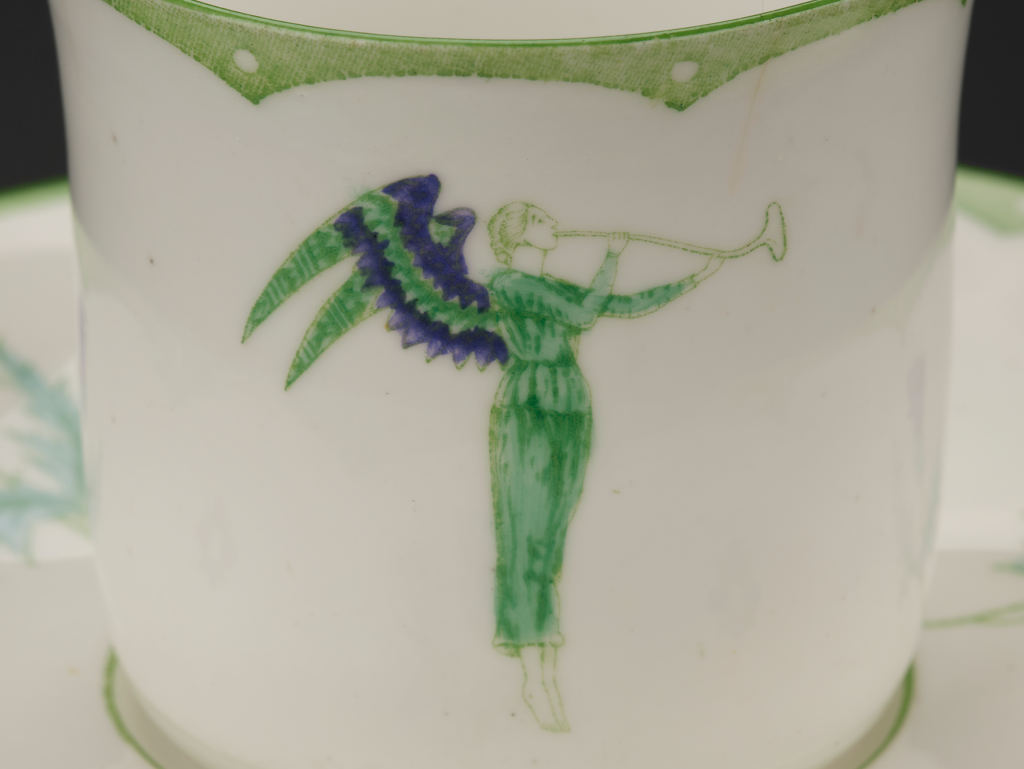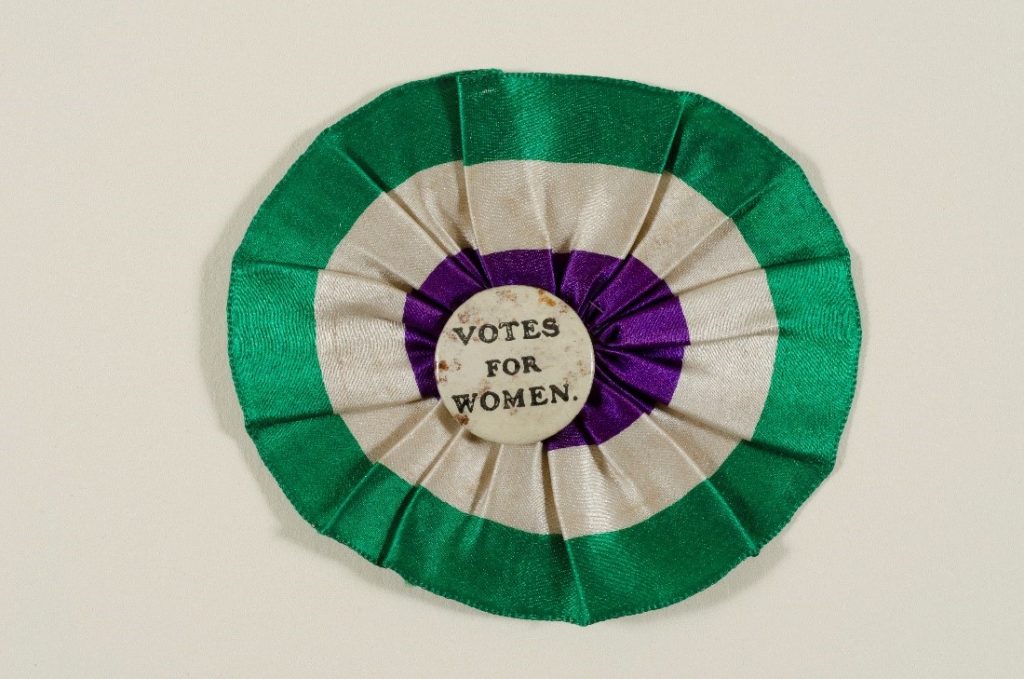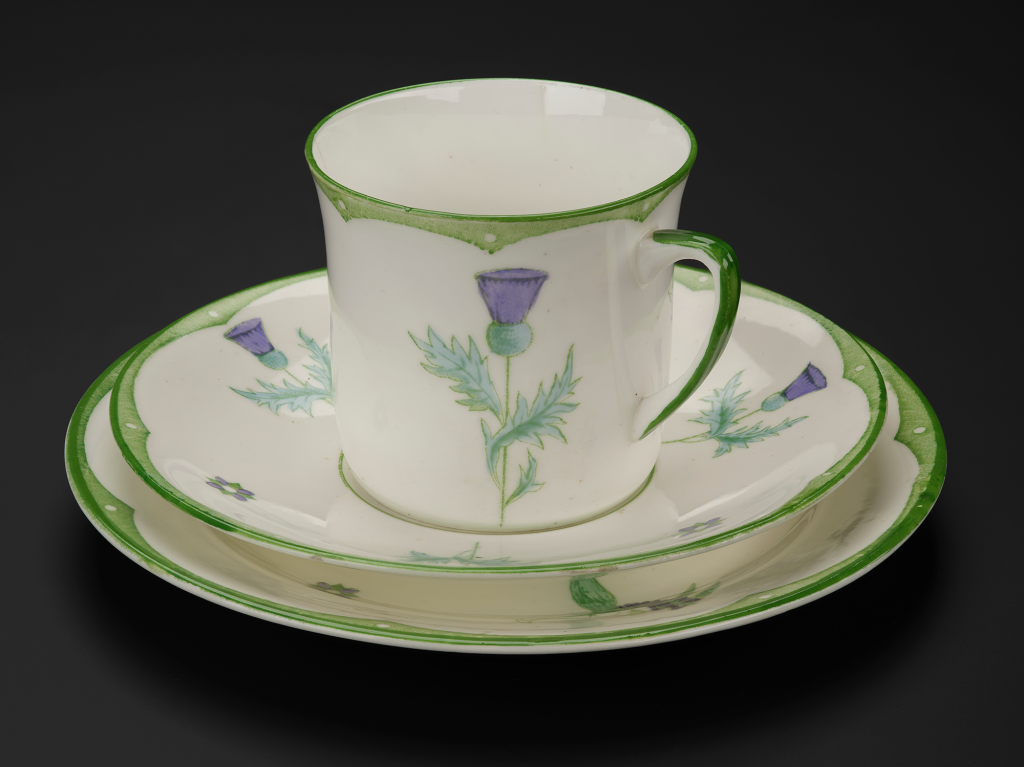How might our design choices inform our values? A recent addition to our collections allows us to explore a group of radical ceramics for Women’s History Month. Claire Blakey, Curator Modern Decorative Arts, talks us through a tea set made to champion women’s suffrage.
Teacups and saucers are probably not top of the list when we think about symbols of political and social protest. However, ceramics have a long history of being used to show support for a particular cause and in 18th century Britain, your choice of teapot could express your support for a radical politician. By the early 20th century, a tea service could be used to show support, and even raise funds, for women’s rights.

The above teacup, saucer and plate set is made of bone china, a ceramic body developed in the Staffordshire Potteries and prized for its durability. It provides the ideal blank canvas for the addition of printed or hand-painted decoration. Made in around 1910 in Longton, the centre of bone china production, its decoration is quite different from the more typical floral fantasies of the period. Instead, this pared down, strikingly modern design focuses on a painted ‘angel of freedom’, designed by artist and campaigner Sylvia Pankhurst (1882–1960).

The angel, shown with a clarion and in long, flowing green robes, became a visual symbol of the Women’s Social and Political Union (WSPU). Pankhurst had founded the WSPU in 1903 alongside her mother Emmeline and sister Christabel. Their cause was women’s suffrage, or Votes for Women. The WSPU was the more militant wing of the women’s suffrage movement, whose frustration at the lack of parliamentary progress on this issue saw them take direct action. This included interrupting political meetings and chaining themselves to the railings outside the Houses of Parliament in Westminster.
They became known as the ‘suffragettes’. Initially this name was used by the press to belittle their cause, but it was quickly co-opted by the group and became a badge of honour. The ‘angel of freedom’ was used on badges, banners and campaign literature, becoming part of the visual branding of the movement.

Raising funds was a vital part of the WSPU’s activities as they were needed to print campaigning material, pay full-time organisers and to organise meetings. Fundraising bazaars were a good way to do this, allowing members to sell hand-made or donated items, as well as WSPU merchandise. The refreshment stall was at the heart of the bazaars, serving tea and often raising the most funds.

Our WSPU trio was made for the refreshment stall of the Grand Suffrage Bazaar and Exhibition held at Charing Cross Halls in Glasgow from 28 – 30 April 1910. A branch of the WSPU was formed in Glasgow in 1906, so the addition of the thistle alongside the angel of freedom represented, and celebrated, the members who would have visited the citywide Scottish Exhibition.
Alongside selling baked goods, millinery and their own WSPU tea, radical performances were held. The Actress Franchise League put on plays including How the Vote Was Won. At the end of the Bazaar, souvenirs such as this trio were sold to raise additional funds. In 1910, a breakfast set for two was advertised for 11 shillings, with a whole tea set at £2. As well as raising vital funds, these ceramics allowed suffragettes and their supporters to take their political message into the domestic sphere.
Drinking and serving tea from the WSPU tea sets was a “polite” way to show allegiance to the cause of women’s suffrage. It allowed an individual to start a conversation over a nice cup of tea with those yet to be convinced. Tea drinking had been a socially acceptable pastime for women since the 18th century and the equipment associated with it had long been used to make political points.
From supporting radical politicians, such as the MP John Wilkes, to championing the movement for the abolition of slavery, these political ceramics were an important part of spreading messages such as the WSPU’s. However, domestic displays of ceramics like this did not always translate into a deep commitment to a cause. But they do show the importance of a distinctive visual identity for these movements.
Choosing what to drink our next cup of tea out of may seem like a neutral act, but it is also a chance to reflect on what our design choices say about our values and beliefs. Something we can all drink to this Women’s History Month.


